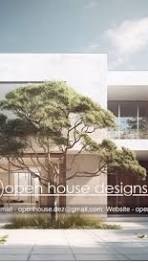Exploring the Evolution of Modern House Design in Contemporary Architecture
The Evolution of Modern House Design
In recent years, modern house design has undergone a significant transformation, reflecting changing lifestyles and technological advancements. Characterised by clean lines, open spaces, and innovative materials, modern architecture continues to push the boundaries of traditional design concepts.
Sleek and Minimalist Aesthetics
One of the defining features of modern house design is its emphasis on simplicity and minimalism. Architects often incorporate large windows to maximise natural light and create a seamless connection between indoor and outdoor spaces. Neutral colour palettes and sleek finishes contribute to a sense of spaciousness and tranquillity.
Integration of Technology
Modern homes are increasingly incorporating smart technologies to enhance comfort and convenience. From automated lighting systems to energy-efficient appliances, technology plays a crucial role in shaping the way we interact with our living spaces. Home automation allows residents to control various aspects of their home environment with just a touch of a button or voice command.
Sustainability and Eco-Friendly Practices
With a growing emphasis on sustainability, many modern house designs integrate eco-friendly features such as solar panels, green roofs, and energy-efficient insulation. Architects are exploring innovative ways to reduce the environmental impact of buildings while creating comfortable and functional living spaces for occupants.
Flexible Floor Plans
Modern house design often prioritises flexibility in floor plans to accommodate changing needs and preferences. Open-concept layouts allow for fluid movement between different areas of the home, while modular furniture enables residents to customise their living space according to their lifestyle.
The Future of Modern House Design
As technology continues to advance and societal values evolve, the future of modern house design holds endless possibilities. Architects are experimenting with new materials, construction techniques, and sustainable practices to create homes that not only meet the needs of today but also anticipate the demands of tomorrow.
Exploring the Benefits of Modern House Design: Aesthetic, Technological, and Sustainable Innovations
- Sleek and minimalist aesthetics create a sense of spaciousness and tranquillity.
- Integration of smart technologies enhances comfort and convenience for residents.
- Emphasis on sustainability promotes eco-friendly practices in modern homes.
- Flexible floor plans allow for customisation to suit changing lifestyle needs.
- Innovative materials and construction techniques push the boundaries of design possibilities.
- Large windows maximise natural light, creating a seamless indoor-outdoor connection.
- Open-concept layouts promote fluid movement between different areas of the home.
Challenges of Modern House Design: Privacy, Maintenance, and Costly Upgrades
Sleek and minimalist aesthetics create a sense of spaciousness and tranquillity.
The sleek and minimalist aesthetics of modern house design play a crucial role in creating a sense of spaciousness and tranquillity within living spaces. By incorporating clean lines, neutral colour palettes, and uncluttered surfaces, architects are able to enhance the perception of openness and airiness. This design approach not only visually expands the room but also fosters a calming atmosphere that promotes relaxation and mindfulness. The simplicity of modern design elements allows for a harmonious balance between form and function, ultimately contributing to a serene and inviting environment for residents to enjoy.
Integration of smart technologies enhances comfort and convenience for residents.
The integration of smart technologies in modern house design brings a multitude of benefits by enhancing the comfort and convenience for residents. From automated lighting and climate control systems to security features that can be remotely monitored, these advancements allow homeowners to create a tailored living environment that adapts to their needs with ease. With just a few taps on a smartphone or a simple voice command, residents can effortlessly control various aspects of their home, making everyday living more efficient and enjoyable. The seamless integration of technology not only elevates the overall living experience but also adds a touch of sophistication to modern homes.
Emphasis on sustainability promotes eco-friendly practices in modern homes.
An important pro of modern house design is the emphasis on sustainability, which promotes eco-friendly practices in contemporary homes. By integrating features such as solar panels, energy-efficient insulation, and green roofs, modern architects are able to reduce the environmental impact of buildings while creating living spaces that are both comfortable and environmentally responsible. This focus on sustainability not only benefits the planet by conserving resources and reducing carbon emissions but also enhances the quality of life for residents by fostering a healthier and more sustainable way of living.
Flexible floor plans allow for customisation to suit changing lifestyle needs.
Flexible floor plans are a key advantage of modern house design, offering the versatility to adapt and customise living spaces to meet evolving lifestyle needs. Whether it’s creating separate zones for work and relaxation, accommodating a growing family, or simply reconfiguring the layout for a fresh look, the flexibility of modern floor plans empowers homeowners to tailor their environment to suit their changing requirements. This adaptability not only enhances functionality but also ensures that the home remains relevant and comfortable for years to come.
Innovative materials and construction techniques push the boundaries of design possibilities.
Innovative materials and construction techniques in modern house design have revolutionised the way architects approach building projects, pushing the boundaries of design possibilities to new heights. From sustainable materials like recycled steel and bamboo to cutting-edge construction methods such as 3D printing and modular building systems, these advancements not only enhance the aesthetic appeal of homes but also improve their functionality and environmental sustainability. By embracing these innovative approaches, architects can create structures that are not only visually striking but also efficient, durable, and adaptable to the evolving needs of residents.
Large windows maximise natural light, creating a seamless indoor-outdoor connection.
One of the key advantages of modern house design is the incorporation of large windows that maximise natural light within the living space. This design feature not only enhances the overall aesthetic appeal of the home but also creates a seamless indoor-outdoor connection. By allowing ample sunlight to filter into the interior, large windows contribute to a bright and airy atmosphere, blurring the boundaries between the inside and outside environments. This not only boosts the visual appeal of the living space but also promotes a sense of openness and connectivity with nature, ultimately enhancing the overall living experience for residents.
Open-concept layouts promote fluid movement between different areas of the home.
Open-concept layouts in modern house design offer a distinct advantage by promoting seamless movement between different areas of the home. By eliminating traditional barriers such as walls and partitions, these layouts create a sense of connectivity and openness, allowing residents to move freely from one space to another. This fluidity not only enhances the visual appeal of the interior but also fosters a sense of spaciousness and versatility, making it easier for individuals to interact with their living environment in a dynamic and flexible manner.
Limited Privacy
In the realm of modern house design, a notable drawback arises in the form of limited privacy. With a focus on open floor plans and expansive windows, these architectural choices can inadvertently compromise the sense of privacy for residents. While these design elements aim to create a seamless connection between indoor and outdoor spaces and maximise natural light, they may also expose inhabitants to unwanted views from neighbours or passers-by. Striking a balance between openness and privacy becomes a crucial consideration in modern house design to ensure that residents feel secure and comfortable within their living spaces.
Maintenance Challenges
The sleek finishes and minimalist aesthetics of modern homes, while visually appealing, can present a significant challenge in terms of maintenance. The clean lines and minimalistic design elements often require more frequent upkeep to preserve their pristine appearance. From high-gloss surfaces that are prone to fingerprints and smudges to delicate materials that require special care, modern house design can demand a greater investment of time and effort to ensure that the home remains in top condition. Balancing the desire for a contemporary look with the practical considerations of maintenance is a key consideration for homeowners embracing modern architecture.
Costly Upgrades
One notable drawback of modern house design is the issue of costly upgrades. The integration of cutting-edge technology and sustainable features often comes at a premium, leading to a substantial rise in both construction and maintenance expenses. While these innovative elements offer long-term benefits such as energy efficiency and enhanced living experiences, the initial investment required can pose a financial challenge for homeowners seeking to embrace the latest trends in architecture and design. As a result, balancing the desire for modern amenities with budget constraints remains a key consideration for those embarking on the journey of building or renovating a contemporary home.


